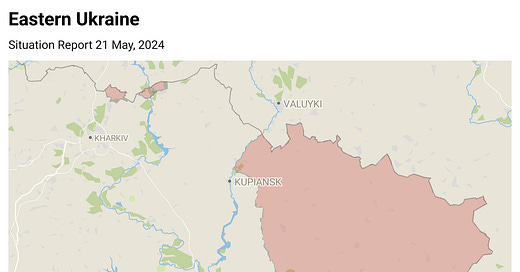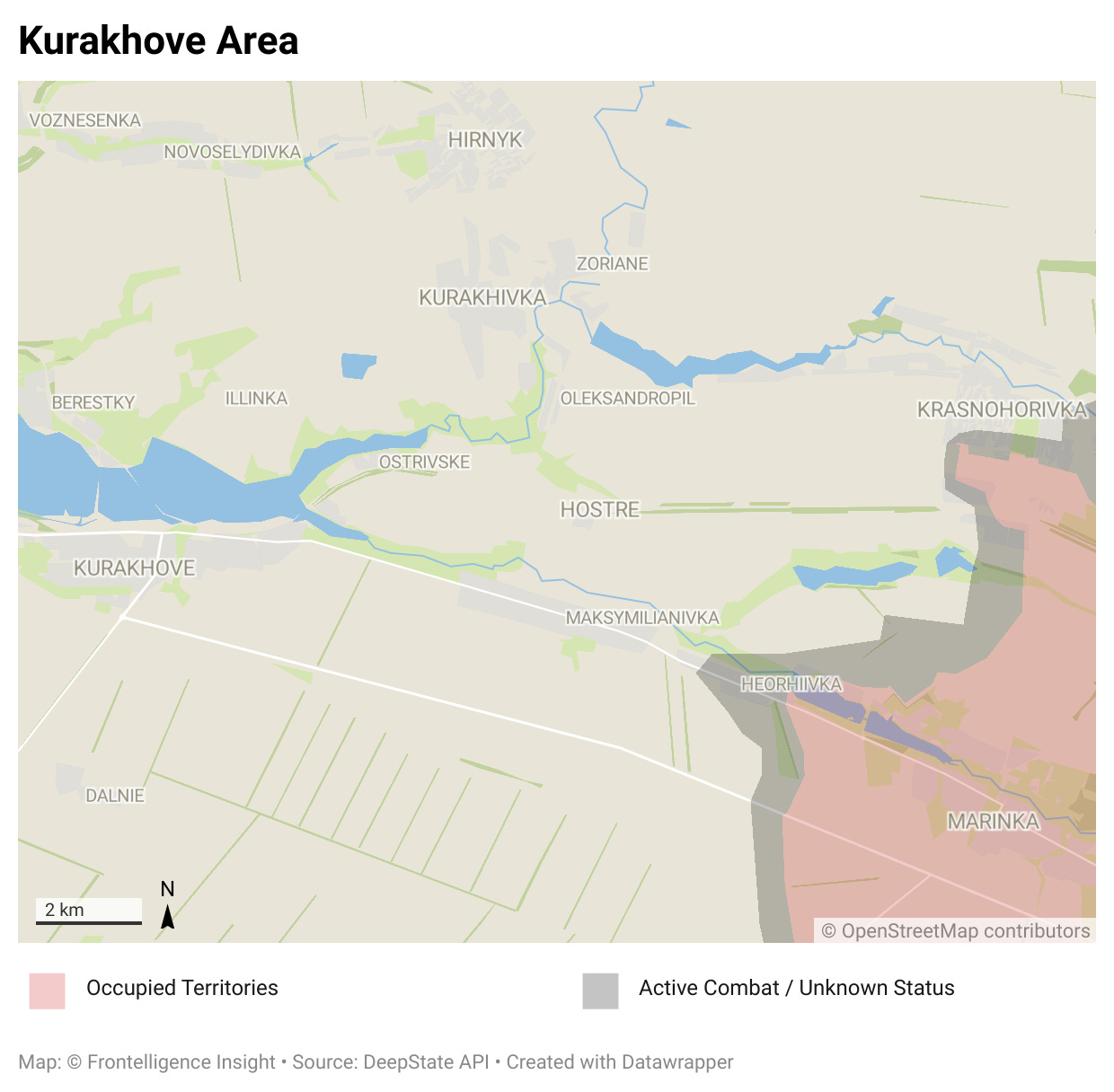Contents
Chasiv Yar
South of Bakhmut
Ocheretyne
Krasnohorivka - Kurakhove area
Summary
The situation on the frontline remains dynamic despite the superficial impression of a static line. As public attention shifted to Kharkiv, the situation in Donbas continued to develop with less public focus. The most significant areas of fighting in Donbas are Ocheretyno, Chasiv Yar, south of Bakhmut, and the Kurakhove-Krasnohorivka area. Russian forces made some tactical gains in Krasnohorivka and Ocheretyno and attempted to assault Chasiv Yar, losing approximately 20 armored vehicles in one day. Meanwhile, despite little news from Ocheretyno, the area is at risk as Russian forces maintain a significant presence, likely preparing for another push. While Russians were able to force the movement of Ukrainian forces to the Kharkiv area to stop the Russian advance, we do not see any penetration or breakthrough in the thinned Ukrainian defenses in Donbas. Despite having much larger resources, Russia is also quite limited. So far, we have observed a series of tactical victories that have not transformed into larger operational success, yet the situation is far from safe. Full details are in the report.
Chasiv Yar
Russia is targeting the city itself, on the left side of the canal, to disrupt command and logistical chains that support Ukrainian troops in the Kanal quarter on the right side. Heavy use of KABs, MLRS, and artillery has been documented, with destruction analyzed by our team using high-resolution imagery.
Russia found a few vulnerable spots in the Kanal quarter district and managed to dismount infantry deep into the area. However, they could not establish a proper foothold and were mostly eliminated by Ukrainian forces. Our team believes that, unfortunately, it is only a matter of time before another push may be more successful than the previous one, which ended disastrously for Russia this time.
Russian troops also made some minor tactical gains in the northern axis of attack in the Kalynivka area towards Chasiv Yar. Overall progress on the northern flank is slower, and Russian forces seem to have struggled despite their original efforts to reach the area with a land bridge over the canal quickly.
Our team still thinks that Chasiv Yar will eventually be lost to Russian Forces. However, the battlefield dynamics show that the assault is already taking a high toll on Russian forces, resulting in the loss of dozens of vehicles as well as airborne troops personnel, which would be required for Russia to advance further once they capture the town. As our team previously outlined, the success for Ukraine in this case would be not in holding Chasiv Yar, but in forcing Russia to spend more resources in taking it than initially allocated, thereby spoiling their plans to take advantage of the seized town due to resource shortages.
South of Bakhmut
Russia claims it has taken Klishchiivka and such claims surface periodically from the Russian side. In reality, Klishchiivka is reduced to rubble, with no surviving structures to hold. Currently, the former settlement is a grey zone where Russians occasionally send small tactical groups to make videos or statements about holding Klishchiivka. However, these groups are often forced to retreat or are killed by Ukrainian defenders positioned on higher ground relative to Klishchiivka.
Overall, the situation hasn't drastically changed and is characterized by daily assaults from the Russian side, leading to little or no results. However, since the Russians can rotate their forces more frequently than the Ukrainian brigades in the area, we might eventually see results from this approach. The area isn't under immediate threat of being captured, but the situation is slowly beginning to favor the Russians and might start snowballing unless Ukrainian troops in the area receive reinforcements.Ocheretyne
Ocheretyne is rarely mentioned lately; however, our team believes it's one of the most dangerous directions at the moment. Russians have a significant number of forces in the area, which they will undoubtedly use to push further. Considering this, we anticipate large pushes either north of Ocheretyne or northwest towards Vozdvyzhenka.
While Ukrainian forces have taken measures to stabilize the line, the distribution of forces is uneven, making the frontline unstable and very risky. Based on our analysis, Russian forces have multiple options for advancing, complicating the defense for the Ukrainian side. Given their limited resources, Ukrainian forces must carefully distribute their troops, and any mistake could result in a penetration of defenses and rapid Russian advances.
The intensity of artillery fire visible on satellite imagery suggests that Russian forces aim to break Ukrainian defenses in the area and continue their movement towards the highway that connects Pokrovsk and Kostyantynivka.The Solovyove area south of Ocheretyne is also quite unstable, with Russians making certain tactical advances. By analyzing satellite imagery, we can identify that in areas where Ukrainian artillery is less present (evidenced by less shelling of Russian advancing forces or concentrations of forces in staging areas), Russian forces are making more gains. This likely indicates that Ukrainian units still face artillery shortages and that ammunition is not distributed evenly, but rather by the criticality of the direction. As a result, Russians are exploiting this and pushing into less defended areas.
Krasnohorivka - Kurakhove area
Russian forces have intensified assaults in Krasnohorivka using mechanized units. While little gains were made and most of these attacks were repelled, this area remains highly unstable. Overall, the area near Kurakhove is heavily fortified and prepared for a siege, so we do not anticipate quick advances by Russian forces in the vicinity of Kurakhove itself. That being said, the threat of eventually losing Krasnohorivka is real. Just as with Chasiv Yar, the question is how much damage Ukrainian defenders can inflict on the assaulters with limited manpower and resources.
Summary
If we zoom out and look at the situation in general, it's clear that, so far, the Russians haven't achieved any significant operational results since the beginning of this offensive. Despite a series of successes in Krasnohorivka, Chasiv Yar, Netailove, and Pervomaysk, Russian forces have not made significant advances outside of Ocheretyne and the Kharkiv area. Our team continues to document the movements of Russian forces from different areas of Russia to the frontlines, indicating that Russia still has reserves and vehicles to conduct offensive operations. Therefore, we should not anticipate a reduction in their offensive pressure despite their losses. Considering that Russian forces still maintain a presence in other areas, such as near the Sumy oblast in the Sudzha area, we assume the offensive hasn't yet reached its peak. Likely, we will see more developments and attempts to thin Ukrainian forces to weaken defenses in Donbas.
At the same time, while Russian forces tend to stick to a general plan and do not deviate much from it, their decisions can be influenced by political leadership. This means that if Putin decides that Kharkiv should become the main axis, he can influence the General Staff to make the necessary adjustments to the plans.
The window of opportunity for Russian forces in this offensive will start to narrow closer to the end of summer when newly mobilized and trained Ukrainian troops begin to arrive in units. This should also coincide with the proper arrival of Western aid, which can help balance the situation. Until then, the main task for Ukrainian forces is to avoid any serious operational failures that the enemy can convert into strategic victories. As we stated earlier in 2023, Ukraine is likely to lose some territories during this Russian offensive, but the main goal is to avoid large operational failures, such as the encirclement of troops in the Kostyantynivka-Bakhmut area, Pokrovsk, and Vuhledar








